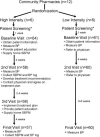Hypertension outcomes through blood pressure monitoring and evaluation by pharmacists (HOME study)
- PMID: 16423096
- PMCID: PMC1490290
- DOI: 10.1111/j.1525-1497.2005.0226.x
Hypertension outcomes through blood pressure monitoring and evaluation by pharmacists (HOME study)
Abstract
Objective: To evaluate the effectiveness of a community pharmacist-based home blood pressure (BP) monitoring program.
Design: Trial of a high-intensity (HI) versus low-intensity (LI) intervention randomized in 12 community pharmacies. The HI intervention comprised 4 face-to-face visits with a trained pharmacist. Pharmacists provided patient-specific education about hypertension. Following the first and third visits, patients were provided with a home BP monitoring device and instructed to measure their BP at least once daily for the next month. Home BP readings were used by the pharmacists to develop treatment recommendations for the patient's physician. Recommendations were discussed with the physician and, if approved, implemented by the pharmacist. In the LI intervention, pharmacists measured patients BP in the pharmacy and referred them to their physician for evaluation.
Participants: Patients with uncontrolled BP at baseline.
Measurements: The main outcomes were the differences in systolic and diastolic BP (SBP and DBP) from baseline to follow-up between the HI and LI patients.
Results: The study enrolled 125 patients, 64 in the HI and 61 in the LI group. From baseline, SBP declined 13.4 mmHg in the HI group and 9.0 mmHg in the LI group. At the final visit, the difference in SBP/DBP change between the HI and LI group was -4.5/-3.2 mmHg (P=.12 for SBP and P=.03 for DBP).
Conclusions: The HI intervention achieved a lower DBP and this model could be a strategy for patients with hypertension.
Figures
References
-
- Fields LE, Burt VL, Cutler JA, Hughes J, Roccella EJ, Sorlie P. The burden of adult hypertension in the United States 1999 to 2000 a rising tide. Hypertension. 2004;44:398–404. - PubMed
-
- Chobanian AV, Bakris GL, Black HR, et al. Seventh report of the Joint National Committee on Prevention, Detection, Evaluation, and Treatment of High Blood Pressure. Hypertension. 2003;42:1206–52. - PubMed
-
- American Heart Association. Dallas, TX: American Heart Association; 2003. Heart Disease and Stroke Statistics—2004 Update.
-
- Hajjar I, Kotchen TA. Trends in prevalence, awareness, treatment, and control of hypertension in the United States, 1988–2000. JAMA. 2003;290:199–206. - PubMed
-
- Cabana MD, Rand CS, Powe NR, et al. Why don't physicians follow clinical practice guidelines? A framework for improvement. JAMA. 1999;282:1458–65. - PubMed
Publication types
MeSH terms
LinkOut - more resources
Full Text Sources
Medical


